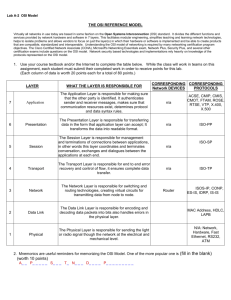1.2 Networking Standards and the OSI Model
advertisement
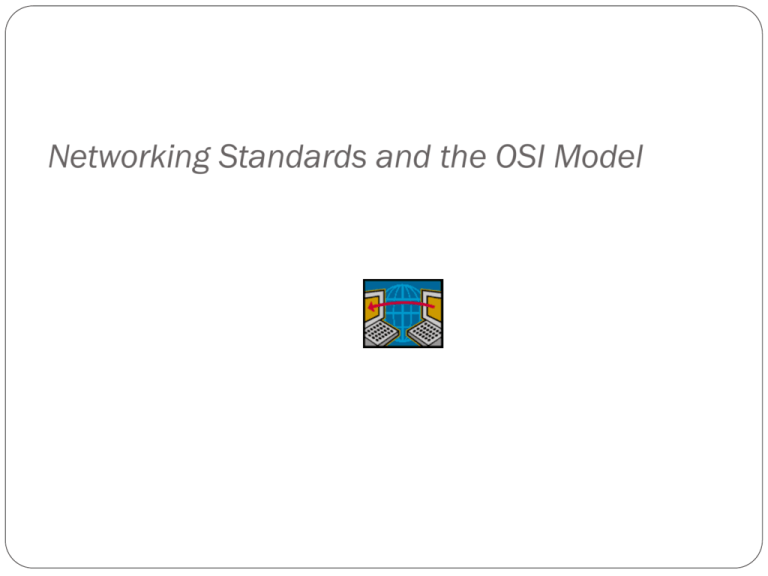
Networking Standards and the OSI Model Networking Standards Organizations Standard Documented agreement containing technical specifications Stipulates design or performance of particular product or service Where would we be without standards? Standards are essential in the networking world Wide variety of hardware and software Ensures network design compatibility Standards define minimum acceptable performance 2 Networking Standards Organizations (cont’d.) Many different organizations oversee computer industry standards Organizations may overlap responsibilities Example: ANSI and IEEE set wireless standards ANSI -> kind of NIC IEEE -> how communication gets there 3 ANSI ANSI (American National Standards Institute) 1000+ representatives from industry and government Determines standards for electronics industry and other fields Requests voluntarily compliance with standards Obtaining ANSI approval requires rigorous testing www.ansi.org 4 IEEE IEEE (Institute of Electrical and Electronics Engineers) Goal of IEEE Promote development and education in electrical engineering and computer science fields Maintains a standards board that establishes its own standards and works with ANSI IEEE technical papers and standards are highly respected (www.ieee.org) 5 ISO ISO (International Organization for Standardization) Headquartered in Geneva, Switzerland Collection of standards organizations Representing 57 countries Goal of ISO Establish international technological standards to facilitate global exchange of information and barrier free trade Widespread authority Not limited to just communications (ex. banking) 6 EIA and TIA EIA (Electronic Industries Alliance) Trade organization Representatives from United States electronics manufacturing firms Lobbies for favorable computer and electronics industries legislation TIA (Telecommunications Industry Association) Focus of TIA Standards for information technology, wireless, satellite, fiber optics, and telephone equipment TIA/EIA 568-B Series Guidelines for installing network cable in commercial buildings 7 ITU ITU (International Telecommunication Union) Specialized United Nations agency Regulates international telecommunications Focus of ITU Global telecommunications issues Worldwide Internet services implementation 8 ISOC ISOC (Internet Society) Founded in 1992 Establishes technical Internet standards ISOC oversees groups with specific missions IETF (Internet Engineering Task Force) Sets Internet system communication standards Particularly protocol operation and interaction Anyone may submit standard proposal Elaborate review, testing, and approval processes 9 IANA and ICANN IANA (Internet Assigned Numbers Authority) and ICANN (Internet Corporation for Assigned Names and Numbers) IP (Internet Protocol) address Address identifying computers in TCP/IP based (Internet) networks Reliance on centralized management authorities IP address management history Initially: IANA (Internet Assigned Numbers Authority) 10 IANA and ICANN (cont’d.) IP address management history (cont’d.) Late 1990s: ICANN (Internet Corporation for Assigned Names and Numbers) took over Private nonprofit corporation Remains responsible for IP addressing and domain name management IANA performs system administration Users and business obtain IP addresses from ISP (Internet service provider) who get it from regional internet registries (RIR) who ultimately get it from ICANN 11 The OSI Model What is the OSI Model? The OSI Model Model for understanding and developing network computer- to-computer communications Developed by ISO (1980s) OSI (Open Systems Interconnection Model) Divides network communications into seven layers Physical, Data Link, Network, Transport, Session, Presentation, Application 13 The OSI Model (cont’d.) Protocol interaction Protocols interact with layer directly above and below Application layer protocols (top) Interact with software (ex. MS Word) Physical layer protocols (bottom) Act on cables and connectors (UTP Cable) 14 The OSI Model (cont’d.) Theoretical representation describing network communication between two nodes Hardware and software independent Every network communication process is represented PDUs (protocol data units) Discrete amount of data Application layer function Flow through layers 6, 5, 4, 3, 2, and 1 Generalized model Sometimes imperfect 15 Figure 2.1 Flow of data through the OSI model 16 Application Layer Top (seventh) OSI model layer No software applications here Protocol functions Facilitates communication between software applications and lower- layer network services Network interprets application request Application interprets data sent from network Software applications negotiate with application layer protocols Formatting, procedural, security, synchronization, and other requirements 17 Presentation Layer Protocol functions Accept Application layer data Formats data Understandable to different applications and hosts Servers as an interpreter Encoding – interpret coding Presentation layer services manage data encryption and decryption (passwords) 18 Session Layer Protocol functions Coordinate and maintain communications between two nodes Session Connection for ongoing data exchange between two parties Connection between remote client and access server Connection between two devices 19 Session Layer (cont’d.) Functions Establishing and keeping alive communications link Keeping communications secure Synchronizing dialogue between two nodes Determining if communications ended Determining where to restart transmission Terminating communications 20 Transport Layer Protocol functions Accept data from Session layer Manage end-to-end data delivery Handle flow control Connection-oriented protocols Establish connection before transmitting data Handshake Three steps ( SYN, SYN-ACK, ACK) Checksum Unique character string allowing receiving node to determine if arriving data unit exactly matches data unit sent by source 21 Transport Layer (cont’d.) Connectionless protocols Do not establish connection with another node before transmitting data Make no effort to ensure data is delivered free of errors More efficient than connection-oriented protocol Useful when data must be transferred quickly Segmentation Breaking large data units received from Session layer into multiple smaller units called segments Increases data transmission efficiency 22 Transport Layer (cont’d.) MTU (maximum transmission unit) Largest data unit network will carry Ethernet default: 1500 bytes Discovery routine used to determine MTU Reassembly Process of reconstructing segmented data units Sequencing Method of identifying segments belonging to the same group of subdivided data 23 Transport Layer (cont’d.) Figure 2-2 Segmentation and reassembly 24 Network Layer Protocols functions Translate network addresses into physical counterparts Decide how to route data from sender to receiver Addressing System for assigning unique identification numbers to network devices Types of addresses for nodes Network addresses (0067973E97F3) Logical addresses (130.115.128.100) 25 Network Layer (cont’d.) Packet formation is here Transport layer segment appended with logical addressing information Routing Determine path from point A on one network to point B on another network Routing considerations Delivery priorities, network congestion, quality of service, cost of alternative routes Fragmentation Network layer protocol (IP) subdivides Transport layer segments received into smaller packets 26 Data Link Layer Protocols functions Divide data received into distinct frames for transmission in Physical layer Frame Structured package for moving data Includes raw data (payload), sender’s and receiver’s network addresses, error checking and control information 27 Data Link Layer (cont’d.) Possible partial communication mistake Not all information received or correctly Frames are not the same Corrected by error checking Possible glut of communication requests Data Link layer controls flow of information Allows NIC to process data without error 28 Data Link Layer (cont’d.) Two Data Link layers Sublayers LLC (Logical Link Control) sublayer MAC (Media Access Control) sublayer MAC address components Block ID Six-character sequence unique to each vendor Device ID Six-character number added at vendor’s factory MAC addresses frequently depicted in hexadecimal format (0067973E97F3) 29 Data Link Layer (cont’d.) Figure 2-5 The Data Link layer and its sublayers 30 Physical Layer Protocol functions Accept frames from Data Link layer Generates signals as changes in voltage at the NIC Copper transmission medium Signals issued as voltage (electrical) Fiber-optic cable transmission medium Signals issued as light pulses (light) Wireless transmission medium Signals issued as electromagnetic waves 31 Physical Layer (cont’d.) Physical layer protocols responsibility when receiving data Detect and accept signals Pass on to Data Link layer Set data transmission rate Monitor data error rates No error checking 32 Applying the OSI Model Table 2-1 Functions of the OSI layers 33 Communication Between Two Systems Data transformation (as seen through the 7 layers) Original software application data differs from application layer - NIC data Header data added at each layer PDUs (protocol data units) Generated in Application layer Segments Generated in Transport layer Unit of data resulting from subdividing larger PDU 34 Communication Between Two Systems (cont’d.) Packets Generated in Network layer Data with logical addressing information added to segments Frames Generated in Data Link layer Composed of several smaller components or fields 35 Communication Between Two Systems (cont’d.) Encapsulation Occurs in Data Link layer Process of wrapping one layer’s PDU with protocol information Allows interpretation by lower layer 36 Communication Between Two Systems (cont’d.) Figure 2-7 Data transformation through the OSI model 37 Frame Specifications Frames Composed of several smaller components or fields Frame characteristic dependencies Network type where frames run Standards frames must follow Ethernet Four different types of Ethernet frames Most popular: IEEE 802.3 standard 38 Frame Specifications (cont’d.) Token ring Ethernet frames and token ring frames differ Will not interact with each other Devices cannot support more than one frame type per physical interface or NIC 39 IEEE Networking Specifications IEEE’s Project 802 Effort to standardize physical and logical network elements Frame types and addressing Connectivity Networking media Error-checking algorithms Encryption Emerging technologies 802.3: Ethernet 802.11: Wireless 40 IEEE Networking Specifications (cont’d.) 41 Table 2-2 IEEE 802 standards Summary Standards and standard organizations ISO’s OSI (Open Systems Interconnection) model Seven layers IEEE’s Project 802 Significant IEEE 802 standards 42 Thanks 43
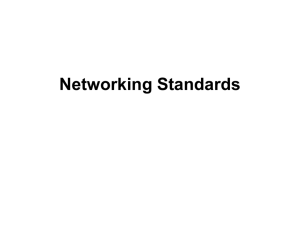
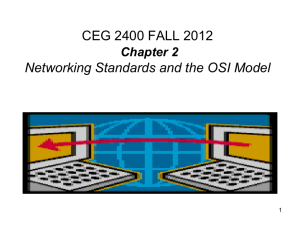




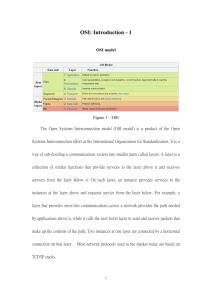
![Network Technologies [Opens in New Window]](http://s3.studylib.net/store/data/008490270_1-05a3da0fef2a198f06a57f4aa6e2cfe7-300x300.png)

